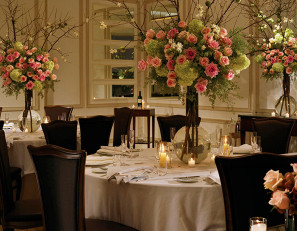![Per Se, the three star restaurant pictured in the top frame, overlooks Central Park and is known for ornate dishes like the one pictured in the bottom frame. [perseny.com]](http://www.jstudentboard.com/reporter/wp-content/uploads/2015/11/obnoxiousfood-150x300.jpg)
Are Michelin stars slowly losing their shine, or are they still a timeless hallmark of the most extraordinary dining experiences?
The small red handbook awards “stars” to the most excellent restaurants around the globe. Michelin inspectors, who the company takes pains to keep anonymous, rate restaurants with zero to three stars. Earning just a single star is considered to be a great achievement, and only a select few restaurants earn more than that; for 2015, only nine restaurants in the US have three stars.
I can personally attest to the quality of three star dining. In 2009, with a reservation made a month in advance, my family dined at Sukiyabashi Jiro in Tokyo. Jiro Ono, the sushi master with three Michelin stars, truly enlightened my tastebuds with the most elegant and delicious 20 pieces of sushi.
Anand Nambakam, who recently dined at New York’s Per Se – a three star restaurant often referred to as the best in the city – told JSR that “a three star from Michelin is a bold statement. The endless pursuit of excellence, attention to detail, and great talent give birth to these stars. When a chef tells you how many Michelin stars he has earned, he doesn’t need to say anything else. He doesn’t need to tell you his menu, his restaurant, or his experience. The stars are a prestigious statement of a certain culinary mastery.”
Yet earning stars is merely the beginning of the battle. When a restaurant’s culinary quality loses its consistency, the restaurant can lose its stars. Losing a star severely impacts the restaurant’s business.
Skye Gingell, awarded a star as head chef of Petersham Nurseries Cafe in Surrey, England, said in a 2012 interview with the Telegraph that Michelin stars are a “curse… Since we got the star we’ve been rammed every single day, which is really hard for such a tiny restaurant. And we’ve had lots more complaints.”
Gingell quit her job due to the extreme stress of retaining her star.
Others say the guide is not stringent enough in its standards. Legendary chef Marco Pierre White, who taught Gordon Ramsay, has questioned the standards of the Michelin guide’s current reviewers and claimed that the guide “dishes out stars like confetti.”
Moreover, some have accused Michelin of bias towards French and Japanese cuisine. Both The Guardian and The New York Times have slighted the guide for favoring their Gallic cultural origins. When Michelin announced Japan as the country with the most stars, The Wall Street Journal reported that multiple Japanese chefs were surprised at receiving a star and suggested that Michelin granted unusual leniency to the Japanese.
Hyung Sik Kim, whose father is currently a chef at the Seoul W Hotel, told JSR that “the Michelin guide is obviously biased against restaurants in Korea. Countless Japanese restaurants were awarded stars, but not one restaurant in Korea has a star.”
Kim continued, “My dad’s restaurant, Namu, served Japanese cuisine to the most famous celebrities, the Korean president, and more. But I can guarantee you that he didn’t serve a Michelin inspector. If he had served an inspector, he would have a star.”
Yet even with these controversies, Michelin stars continue to hold their place as badges of culinary excellence. Chefs will still strive to earn stars and still feel dread over the annual publication of the Red Guide Book, and few aspiring chefs will publically criticize the guide as earning a star often brings in bookings for the next two months. Likewise, few are willing to displease Michelin, which can wither a fully booked restaurant by taking away a star.
The dilemma of the Michelin stars will continue to boil and cool the culinary culture behind kitchen doors.

